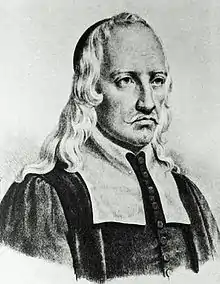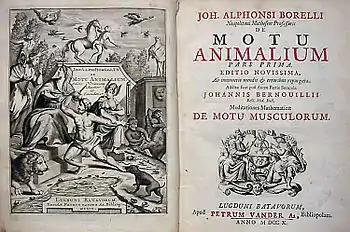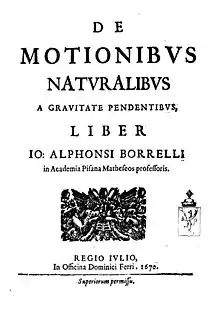Giovanni Alfonso Borelli
Giovanni Alfonso Borelli (Italian pronunciation: [dʒoˈvanni alˈfɔnso boˈrɛlli]; 28 January 1608 – 31 December 1679) was a Renaissance Italian physiologist, physicist, and mathematician. He contributed to the modern principle of scientific investigation by continuing Galileo's practice of testing hypotheses against observation. Trained in mathematics, Borelli also made extensive studies of Jupiter's moons, the mechanics of animal locomotion and, in microscopy, of the constituents of blood. He also used microscopy to investigate the stomatal movement of plants, and undertook studies in medicine and geology. During his career, he enjoyed the patronage of Queen Christina of Sweden.
Giovanni Alfonso Borelli | |
|---|---|
 | |
| Born | 28 January 1608 Naples, Italy |
| Died | 31 December 1679 (aged 71) Rome, Italy |
| Burial place | San Pantaleo, Rome |
| Nationality | Italian |
| Alma mater | Sapienza University of Rome |
| Scientific career | |
| Fields | Physiologist, physicist, mathematician |
| Academic advisors | Benedetto Castelli |
| Notable students | Marcello Malpighi |
Biography
Giovanni Borelli was born on 28 January 1608 in the district of Castel Nuovo, in Naples. He was the son of Spanish infantryman Miguel Alfonso and a local woman named Laura Porello (alternately Porelli or Borelli.)
Borelli eventually traveled to Rome where he studied under Benedetto Castelli, matriculating in mathematics at Sapienza University of Rome. Sometime before 1640 he was appointed Professor of Mathematics at Messina. In the early 1640s, he met Galileo Galilei in Florence. While it is likely that they remained acquaintances, Galileo rejected considerations to nominate Borelli as head of Mathematics at the University of Pisa when he left the post himself. Borelli would attain this post in 1656. It was there that he first met the Italian anatomist Marcello Malpighi.
Borelli and Malpighi were both founder-members of the short-lived Accademia del Cimento, an Italian scientific academy founded in 1657. It was here that Borelli, piqued by Malpighi's own studies, began his first investigations into the science of animal movement, or biomechanics. This began an interest that would continue for the rest of his life, eventually earning him the title of the Father of Biomechanics. Borelli's involvement in the Accademia was temporary and the organization itself disbanded shortly after he left.
Borelli returned to Messina in 1668 but was quickly forced into exile for suspected involvement in political conspiracies. Here he first became acquainted with ex-Queen Christina of Sweden who had also been exiled to Rome for converting to Catholicism. Borelli lived the rest of his years in poverty, teaching basic mathematics at the school of the convent where he had been allowed to live. He never saw the publication of his masterwork, De Motu Animalium (On the Movement of Animals) as it was published posthumously, financed by Christina and his benefactors at the convent.

Scientific achievements
Borelli's major scientific achievements are focused on his investigation into biomechanics. This work originated with his studies of animals. His publications, De Motu Animalium I and De Motu Animalium II, borrowing their title from the Aristotelian treatise, relate animals to machines and utilize mathematics to prove his theories. The anatomists of the 17th century were the first to suggest the contractile movement of muscles. Borelli, however, first suggested that 'muscles do not exercise vital movement otherwise than by contracting.' He was also the first to deny corpuscular influence on the movements of muscles. This was proven through his scientific experiments demonstrating that living muscles did not release corpuscles into the water when cut. Borelli also recognized that forward motion entailed the movement of a body's center of gravity forward, which was then followed by the swinging of its limbs in order to maintain balance. His studies also extended beyond muscle and locomotion. In particular, he likened the action of the heart to that of a piston. For this to work properly he derived the idea that the arteries have to be elastic. For these discoveries, Borelli is labeled as the father of modern biomechanics, and the American Society of Biomechanics uses the Borelli Award as its highest honor for research in the area.[1]
Along with his work on biomechanics, Borelli also had interests in physics, specifically the orbits of the planets.[2] Borelli believed that the planets were revolving as a result of three forces. The first force involved the planets' desire to approach the sun. The second force dictated that the planets were propelled to the side by impulses from sunlight, which is corporeal. Finally, the third force impelled the planets outward due to the sun's revolution. The result of these forces is similar to a stone's orbit when tied on a string. Borelli's measurements of the orbits of satellites of Jupiter are mentioned in Volume 3 of Newton's Principia.

Borelli is also considered to be the first person to consider a self-contained underwater breathing apparatus along with his early submarine design.[3][4] The exhaled gas was cooled by sea water after passing through copper tubing. The helmet was brass with a glass window and 0.6 m (2 ft) in diameter. The apparatus was never likely to be used or tested.[5] He discovered the principle of the heliostat more than sixty years before Willem 's Gravesande.[6]
Other works

Borelli also wrote:
- Delle cagioni delle febbri maligne della Sicilia negli anni 1647 e 1648 (Cosenza, 1649)
- Euclides Restitutus (Pisa, 1658)
- Apollonii Pergaei Conicorum libri V, VI, VII (in Latin). Florence. Giuseppe Cocchini. 1661.
- Theoricae Mediceorum planetarum ex causis physicis deductae (Florence, 1666)
- De vi percussionis (in Latin). Bologna. ex typographia Iacobi Montij. 1667.
- Meteorologia Aetnea (in Latin). Reggio Calabria. Domenico Antonio Ferro. 1669.
- Historia et meteorologia incendii Aetnaei anni 1669 (in Latin). Reggio Calabria. Domenico Antonio Ferro. 1670.
- De motionibus naturalibus a gravitate pendentibus (in Latin). Reggio Calabria. Domenico Antonio Ferro. 1670.
References
- Borelli Award Archived 12 December 2010 at the Wayback Machine, American Society of Biomechanics
- Giovanni Alfonso Borelli, Theoricae Mediceorum Planetarum ex Causis Physicis Deductae [Theory [of the motion] of the Medicean planets [i.e., moons of Jupiter] deduced from physical causes] (Florence, (Italy): 1666).
- Davis, RH (1955). Deep Diving and Submarine Operations (6th ed.). Tolworth, Surbiton, Surrey: Siebe Gorman & Company Ltd. p. 693.
- Quick, D. (1970). "A History of Closed Circuit Oxygen Underwater Breathing Apparatus". Royal Australian Navy, School of Underwater Medicine. RANSUM-1-70. Archived from the original on 9 May 2008. Retrieved 17 March 2009.
{{cite journal}}: CS1 maint: unfit URL (link) - Acott, C. (1999). "A brief history of diving and decompression illness". South Pacific Underwater Medicine Society Journal. 29 (2). ISSN 0813-1988. OCLC 16986801. Archived from the original on 27 June 2008. Retrieved 17 March 2009.
{{cite journal}}: CS1 maint: unfit URL (link) - Knowles Middleton 1973, p. 329.
Sources
- Butterfield, H. (1950) The Origins of Modern Science. London: Bell and Sons Ltd.
- Centore, F. (1970) Robert Hooke's Contributions to Mechanics. The Hague: Martinus Nijhoff.
- Gillespie, C. ed. (1971) Dictionary of Scientific Biography. New York: Linda Hall Library.
- Knowles Middleton, W. E. (1973). "Giovanni Alfonso Borelli and the Invention of the Heliostat". Archive for History of Exact Sciences. 10 (3/4/5): 329–341. JSTOR 41133367.
- Bertoloni Meli, Domenico (1998). "Giovanni Borelli and the Study of Human Movement: An Historical Review". The British Journal for the History of Science. 31 (4): 383–402. JSTOR 4027873.
- Thurston, A. J. (1999). "Giovanni Borelli and the Study of Human Movement: An Historical Review". Aust. N. Z. J. Surg. 69 (4): 276–88. doi:10.1046/j.1440-1622.1999.01558.x.
- Gribbin, J. (2002) The Scientists. Random House. ISBN 1-4000-6013-3
Further reading
- Settle, Thomas (1970–1980). "Borelli, Giovanni Alfonso". Dictionary of Scientific Biography. Vol. 2. New York: Charles Scribner's Sons. pp. 306–314. ISBN 978-0-684-10114-9.
- Montacutelli, Stefania (2013). "Borelli, Giovanni Alfonso". Il Contributo italiano alla storia del Pensiero: Scienze. Istituto dell'Enciclopedia Italiana. Retrieved 12 August 2023.
External links
 Media related to Giovanni Alfonso Borelli at Wikimedia Commons
Media related to Giovanni Alfonso Borelli at Wikimedia Commons- Baldini, Ugo (1970). "BORELLI, Giovanni Alfonso". Dizionario Biografico degli Italiani, Volume 12: Bonfadini–Borrello (in Italian). Rome: Istituto dell'Enciclopedia Italiana. ISBN 978-8-81200032-6.
- Works by Giovanni Alfonso Borelli at Open Library
- Gaedike, R.; Groll, E. K. & Taeger, A. 2012: Bibliography of the entomological literature from the beginning until 1863 : online database – version 1.0 – Senckenberg Deutsches Entomologisches Institut.